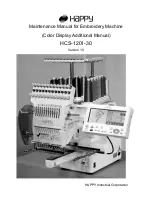
SEWING THE STITCHES
90
■
Sewing Stretch Fabrics
When sewing a buttonhole on stretch fabrics, press
or
, and use a gimp thread.
a
Hook the gimp thread onto the back of
buttonhole foot “A”, and then pull the ends of
the gimp thread under the presser foot. Pass
the thread ends through the grooves at the
front of the presser foot, and then temporarily
tie them.
* Use #5 embroidery thread or lace yarn for the gimp
thread.
a
Upper thread
b
Lower the presser foot lever, and then start
sewing.
* Set the stitch width to the width of the gimp thread.
c
When sewing is finished, gently pull the gimp
thread to remove any slack, and then use a
handsewing needle with a large eye to pull
the gimp thread to the wrong side of the
fabric.
d
Tie the ends together, and then trim the
excess.
* After using the seam ripper to cut the threads sewn
over the buttonhole, trim the threads.
■
Buttons That Do Not Fit into the Button
Holder Plate
Use the markings on the presser foot scale to set the
size of the buttonhole. The distance between the
markings on the presser foot scale is 5 mm (approx.
3/16 inch).
Add together the diameter and thickness of the
button, and then set the button holder plate to the
calculated value.
a
Button holder plate
b
Presser foot scale
c
Finished measurement (di thickness)
d
5 mm (approx. 3/16 inch)
Example:
For a button with a diameter of 15 mm
(approx. 9/16 inch) and a thickness of
10 mm (approx. 3/8 inch), the scale
should be set at 25 mm (approx. 1 inch).
a
Thickness: 10 mm (approx. 3/8 inch)
b
Diameter: 15 mm (approx. 9/16 inch)
a
a
b
c
d
a
b
Summary of Contents for Symphony BLSY
Page 1: ......
Page 2: ......
Page 10: ...8 ...
Page 50: ...USEFUL FUNCTIONS 48 ...
Page 102: ...SEWING THE STITCHES 100 ...
Page 120: ...COMBINING STITCH PATTERNS 118 Examples of Pattern Combinations ...
Page 151: ......
Page 152: ...English 882 U65 XE8666 001 Printed in Taiwan ...
















































